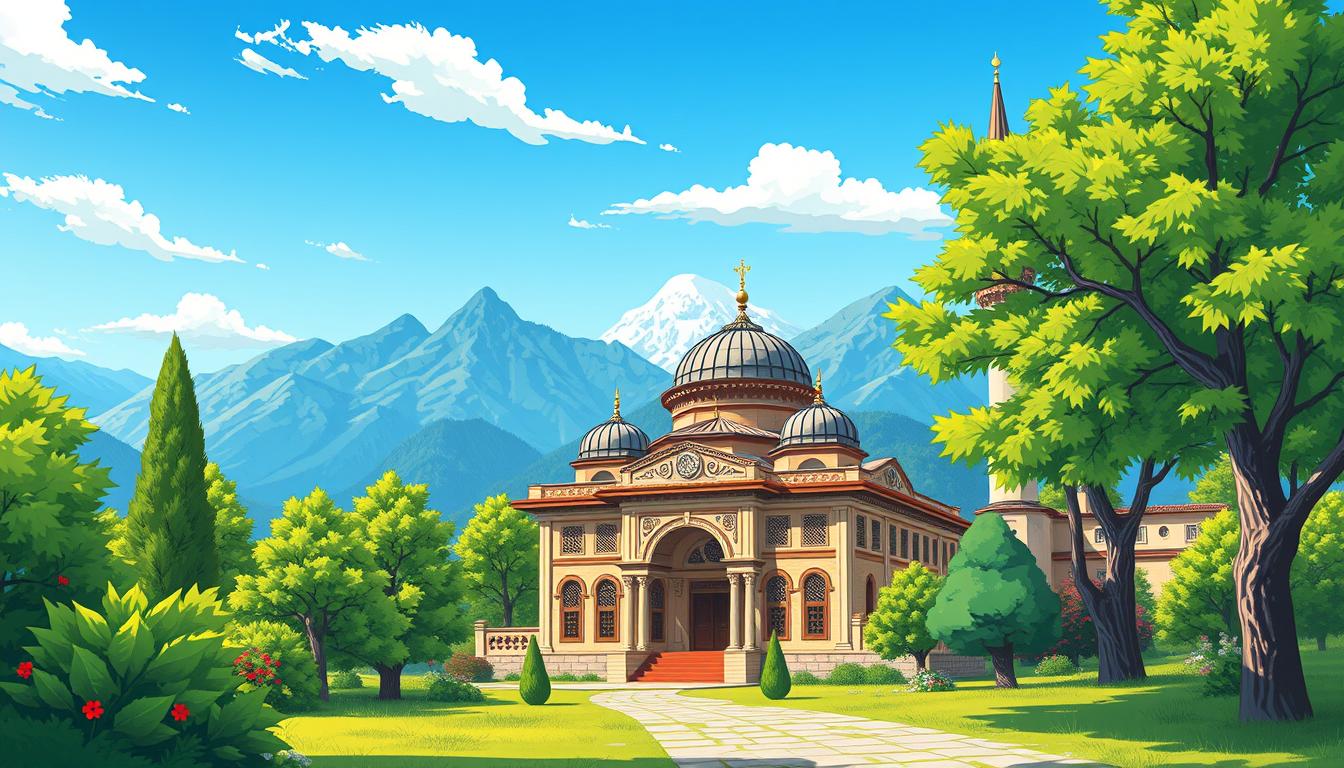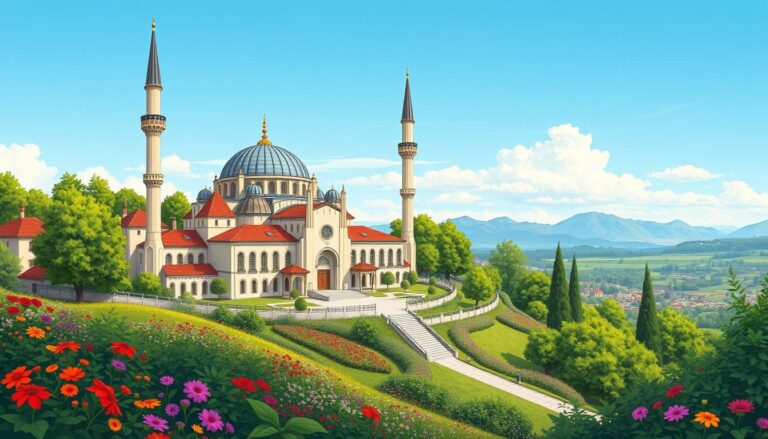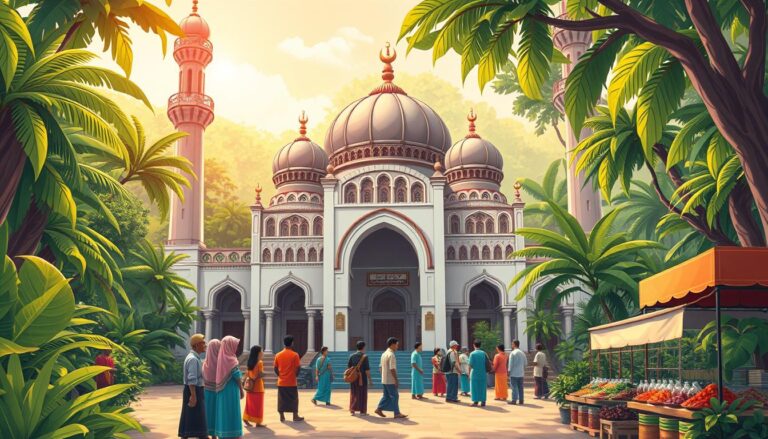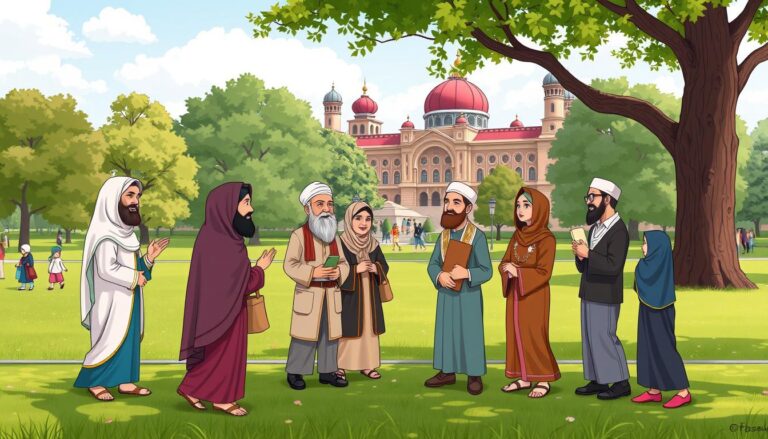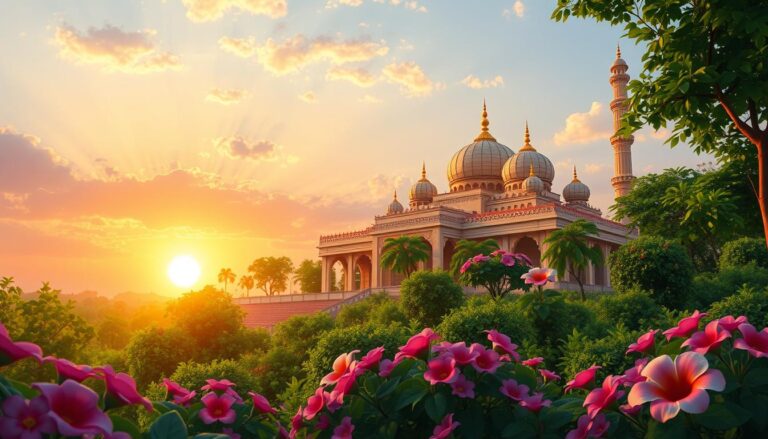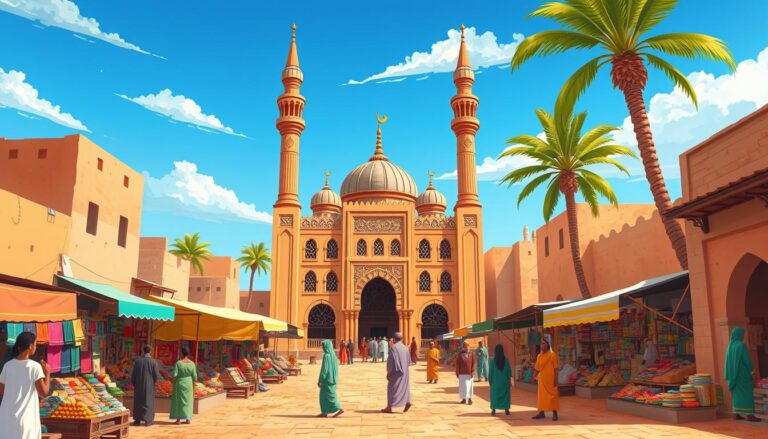Islam in Albania
The 2023 census shows that Islam is the main religion in Albania. About 45.86% of people are Sunni Muslims, and 4.81% are Bektashi Muslims. The rest of the population includes 8.38% Catholics, 7.22% Eastern Orthodox, and 0.4% Evangelicals.
Only 0.15% belong to other religions. Also, 13.82% say they believe but don’t specify a religion. Another 3.55% are Atheists, and 15.76% didn’t answer the question. This shows a 22% drop in religious belief since 1945.
Islam came to Albania during the Ottoman period. Many Albanians turned to Islam under Ottoman rule. But, the 20th-century governments pushed for secularization, changing religious practices a lot.
After communism ended, Islam in Albania started to grow again. This was thanks to support for infrastructure, literature, education, and social activities.
Introduction to Islam in Albania
Islam has a long history in Albania, starting with the Ottoman period. During this time, most Albanians converted to Islam. The country’s relationship with Islam has changed a lot over the years, influenced by politics, society, and culture.
Historical Background
In the late Middle Ages, Albanians were mostly Catholic or Orthodox. Their religion was often linked to politics. But in the 18th century, things changed. Offers like lower taxes and land helped many Albanians turn to Islam.
After Albania became independent in 1912, it didn’t have an official religion. This meant everyone could practice their faith freely. Yet, all governments in the 20th century pushed for secularism. This effort was strongest under the People’s Socialist Republic of Albania, causing a drop in religious activities.
Demographics of Islam in Albania
Today, Albania’s religious scene is diverse. About 70% of the population has a Muslim background. Another 20% are Greek Orthodox, and 10% are Roman Catholic. These numbers have changed due to events like the Balkan Wars and World War I.
In the 1920s, Muslims made up about 70% of Albanians. This made Albania the only Muslim-majority country in Europe. But, the government under Ahmet Zog I tried to limit Islam’s role. They modernized Islamic institutions and replaced Sharia law with Western law.
The last census on religious affiliations in Albania was in 1938. Since then, the country has seen big changes. These include banning all religious activities from 1967 to 1991 under communism.
“Albania has been historically known for its strong tradition of religious tolerance.”
Arrival of Islam in Albania
The arrival of Islam in Albania started in the late 14th century. This was when Albanians joined the growing Ottoman Empire. The early Ottoman period in Albania saw a slow but steady acceptance of Islam by the people.
Early Ottoman Period
In the early 1430s, the Ottomans faced opposition from Albanian lords in the north and center. They launched two military campaigns, defeating the Albanian resistance. This victory led to the Ottomans giving land to Anatolian timars and some to Albanian leaders.
Some Albanian Christians converted to Islam early on. They wanted to keep their old status and join the new class of timar holders. This conversion helped Islam start to become part of Albanian society.
“The arrival of Islam in Albania can be traced back to the late 14th century when Albanians became part of the expanding Ottoman Empire.”
The early acceptance of Islam in Albania was a key step. It helped Islamic practices and traditions become part of Albanian culture. This set the stage for Islam to spread more widely in the country over time.
Spread of Islam in Northern Albania
The spread of Islam in northern Albania was slow. This was mainly because of the strong Roman Catholic Church and the tough terrain. The Catholic Albanian rebellions against the Ottoman Empire led to harsh punishments. This made many Catholics turn to Islam.
Resistance from the Catholic Church
The Roman Catholic Church worked hard to stop Islam in northern Albania in the 16th century. The mountains made it hard for Islam to spread. But, the Ottoman Empire’s growth slowly changed the religious scene.
Impact of Rebellions and Reprisals
The Catholic Albanian rebellions had a big effect on the area. The harsh punishments for rebels made many Catholics leave their faith. For example, in Lezhë, the Catholic numbers dropped by 50% in the 1630s-1670s. In Pult, the number of Catholics fell from 20,000 to 4,045, with many turning to Islam.
“The quick acceptance of Islam by the Albanians and other nations in the Balkan Peninsula was influenced by historical, social, and religious conditions dating back to the 14th and 15th centuries.”
Islamization in Southern Albania
The Islamization of Albania took place over many centuries. It was in the 19th century that this process really took off, especially in the South.
In the 16th century, most areas where Albanians lived were still Christian. Muslims made up less than 5% in most places. But, other Balkan regions like Bosnia and Northern Greece had more Muslims by then.
By the 17th and 18th centuries, Islam spread more in Albania. This led to more Albanians becoming Sunni Muslim. Yet, some Christian Albanians still lived in certain areas.
“The Islamization of Albania was a gradual process that occurred over several centuries, with the peak happening in the 19th century, particularly in the Southern parts of the country.”
By the 16th century, cities like Lezhë and Shkodër had mostly Muslim populations. But, Northern Albania was slower to adopt Islam. This was due to resistance from the Catholic Church and the tough terrain.
Catholic Albanian rebellions led to harsh punishments. This made many turn to Islam. The number of Catholics in places like Lezhë and Pult dropped a lot between the 1630s and 1670s.
The topic of Islamization in Albania is complex and debated. Some see it as a way to identify with conquerors. Others believe it was the only way to keep their ethnic identity. The impact of Islamization in Southern Albania is undeniable, shaping its culture and religion for centuries.
Role of Ottoman Administration
In the early days of Ottoman rule in Albania, many important churches were turned into mosques. This was done to show the Ottoman power and influence. The first mosques in Albania were built in fortresses to house Ottoman soldiers. They were ordered by the Ottoman Sultans during their military campaigns.
The Ottomans were always careful of Catholicism but mostly left the Orthodox church alone. However, there were times when the church faced tough times, like when bishops were kicked out and properties were taken. The Ottoman rule also hurt the Catholic church a lot, destroying many of its buildings.
Conversion Incentives
The Ottoman government used different ways to get more people to become Muslim. They offered:
- Free from taxes and other economic benefits for those who became Muslim
- Land and property to Muslim owners, called beys, who had a lot of power
- Rules that made it hard for non-Muslims, like the devşirme system, which took Christian boys for the military
Because of these actions and the pressure from the Ottomans, about two-thirds of Albanians became Muslim by the 17th and 18th centuries.
“The Bektashi dervishes, a mystic Islamic sect, became the largest religious group in southern Albania after the disbandment of the janissaries in 1826. This sect played a key role in the Albanian nationalist movement of the late nineteenth century and promoted religious tolerance among Albanians.”
Islam in Albania
Albania, a Balkan nation, is known for its rich religious diversity. Islam is a big part of the country’s culture and society. It has a long history in Albania, influencing both Sunni and Bektashi Muslims.
Sunni and Bektashi Muslims
The 2011 census shows Sunni Muslims make up about 57% of Albania’s 3.1 million people. The Bektashi Order, a Sufi tradition, has 2% of the population. These two Muslim groups have lived together in Albania for centuries, each with their own traditions.
Islamic Practices and Traditions
Islam has a deep history in Albania, with many religious practices and traditions. During Ottoman rule, many mosques, madrasas, and Sufi lodges were built, especially in Ergiri (Gjirokastër). But, the communist era under Enver Hoxha destroyed much of this heritage, including mosques and shrines.
After communism, Islamic practices and traditions in Albania began to flourish again. The government now helps the Sunni Albanian Muslim Community (AMC) and the Bektashi Muslim community. This support helps restore and maintain religious sites.
“Albania is one of three European countries, along with Bosnia-Herzegovina and Kosovo, with Muslim-majority populations.”
Today, Islam remains important in Albania’s culture and society. Both Sunni and Bektashi Muslims practice their faith with great passion and respect.
Impact of Communism on Islam
The Albanian National Awakening (Rilindja) and the de-emphasis of religious tradition set the stage for the government’s secularization policy in the 20th century. This policy had a profound impact on Islam, as well as other faiths, in the country.
Secularization Policy
Under the People’s Socialist Republic of Albania, the government aggressively pursued a policy of state atheism. Decades of this policy, which ended in 1991, resulted in a significant decline in religious practice across all traditions. According to the 1945 census, Muslims comprised 72% of the population, but by 1967, Albania had declared itself an atheist state.
In the period from 1967 to 1991, the communist regime destroyed 2,169 religious buildings and other monuments within seven months, with 530 of them belonging to the Bektashi order. By the end of the regime, only about 50 mosques remained out of the roughly 1,127 Islamic buildings that existed in Albania prior to the communists’ rise to power.
Albanians were forced to deny their religion and adopt the socialist way of life that praised secular gods like the Communist Party and its leaders. This had a profound impact on the role of Islam in Albania and the secularization policy implemented by the government.
“Albania became the first constitutional atheist state globally with the adoption of the communist constitution in 1976.”
The communist regime’s actions, including the nationalization of religious estates in 1946, effectively marginalized the role of Islam and other faiths in Albanian society. This set the stage for the post-communist era, where foreign actors played a significant role in the revival of religion due to the absence of qualified clergy and religious institutions for over three decades.
Revival of Islam in Post-Communist Era
After communism ended in Albania, Islam saw a big comeback. Laws that once blocked it were lifted. This allowed mosques, schools, and more to be rebuilt. But, Muslim communities in Albania faced many hurdles in this comeback.
Restoration of Religious Institutions
One big job for Muslims was fixing mosques and schools taken by the communists. They also worked on Sufi lodges, or tekkes. The Sixth World Bektashi Congress in 1993 helped the Bektashi community a lot.
Challenges Faced by Muslim Communities
- Muslims had to get people back to praying after fifty years of communism.
- The Bektashi community had money problems, with little help from abroad.
- The Democratic Party wanted to help Muslims to win votes, especially in poor areas.
- Fixing mosques and building new ones was a big job that needed a lot of money and effort.
Despite these problems, the Revival of Islam in Post-Communist Albania, the Restoration of Religious Institutions, and the Challenges Faced by Muslim Communities were key parts of Albania’s religious scene after communism.
Interfaith Relations in Albania
Albania, a small Balkan nation, is known for its religious diversity. Despite a complex history, the people have shown mutual understanding and tolerance. This is true among different faith communities.
The population of 3.1 million is mostly Muslim, with Sunni Muslims making up nearly 57%. Roman Catholics and the Albanian Autocephalous Orthodox Church each have 10% and 7% of the population, respectively. The Bektashi Order, an Islamic Sufi order, has 2% of the population. Other religious groups, like Protestants, Baha’is, Jehovah’s Witnesses, and Jews, also exist in the country.
The Interfaith Council of Albania was set up in 2007. It brings together the five major religious communities for dialogue. The U.S. embassy supports programs that promote inclusivity and women’s empowerment in religious communities.
“Albania has a history of religious tolerance and pluralism, which has served as a unifying element between various groups in society,” said the President of Albania in a speech at the Oxford Forum in 2005.
Albania’s history of religious pluralism has fostered mutual respect among faith communities. This tradition is seen as a key asset in Albania’s bid to join the European Union.
Property Restitution and Compensation
Since the 1990s, Albania has struggled with Property Restitution and Compensation. The legal rules for this process have been tough to follow. Religious groups still worry about getting back properties taken by the old communist regime.
Legal Framework
The State Agency of the Cadaster has found it hard to give back property to religious groups. This is mainly because other buildings, legal or illegal, now occupy these properties. Also, finding suitable properties for in-kind compensation is a big problem.
Challenges in Property Restitution
- The Bektashi community, the Albanian Orthodox Church (AOC), and the Albanian Muslim Community (AMC) face issues defending their property rights.
- The government has worked to legalize buildings built by religious groups. This includes over 200 buildings in 2021 and 2022.
- Yet, religious groups still worry about the slow return of their properties.
The Property Restitution and Compensation process in Albania is still a big challenge. Religious groups keep pushing for the return of their rightful properties.
“The State Agency of the Cadaster has reported problems returning property to religious communities, stating that this was mainly because properties were occupied with other legally and illegally constructed buildings, and it said in-kind compensation was limited by insufficient available property.”
Conclusion
Islam has greatly influenced Albania’s history and culture. It was mainly introduced during the Ottoman period. This led to most Albanians converting to Islam.
However, the 20th century saw a drop in religious practice. This was due to the communist regime’s secularization policies.
In the post-communist era, Islam saw a comeback. But Muslim communities faced hurdles in getting back their religious sites and properties. The communist regime had taken them away.
Despite these obstacles, Albania has kept a good relationship between different faiths. The government has helped in returning religious properties. It also promotes religious diversity and tolerance.
A small part of Albanian Muslims support Sharia law and suicide bombing. But most Albanians stick to secularism and religious tolerance. The country’s laws protect freedom of belief and conscience.
These laws also let religious groups play a role in making policies. This gives faith communities more say in matters of belief.
Source Links
- Islam in Albania
- Islamization of Albania
- Albania’s Muslim population drops below 50% for first time in centuries – Türkiye Today
- Islam in Albania (1913–1944)
- Islam in Albania
- Islam, Albania, and European Integration: The Vague Role of National Identity in Albanian Secularism
- The First Contacts of Islam with Balkans
- Islam
- Islam In ALBANIA
- Islamization — Seed of Discord or the Only Way of Salvation for Albanians?
- MUSLIM IDENTITY IN THE BALKANS BEFORE THE ESTABLISHMENT OF NATION STATES
- Ottoman Albania
- Albanians Under Ottoman Rule (Albania)
- Albania – United States Department of State
- My journey to Albania in search of Europe’s Muslim heritage
- Islam in the People’s Socialist Republic of Albania
- Importing Religion into Post-Communist Albania: Between Rights and Obligations
- The revival of Islam in the Balkans : from identity to religiosity
- Albanian national identity and Islam in the post-communist era
- Albania – United States Department of State
- Freedom of religion in Albania
- 2012 Report on International Religious Freedom – Albania | Refworld
- Radicalisation and Governance of Islam in Albania – Tirana Observatory

